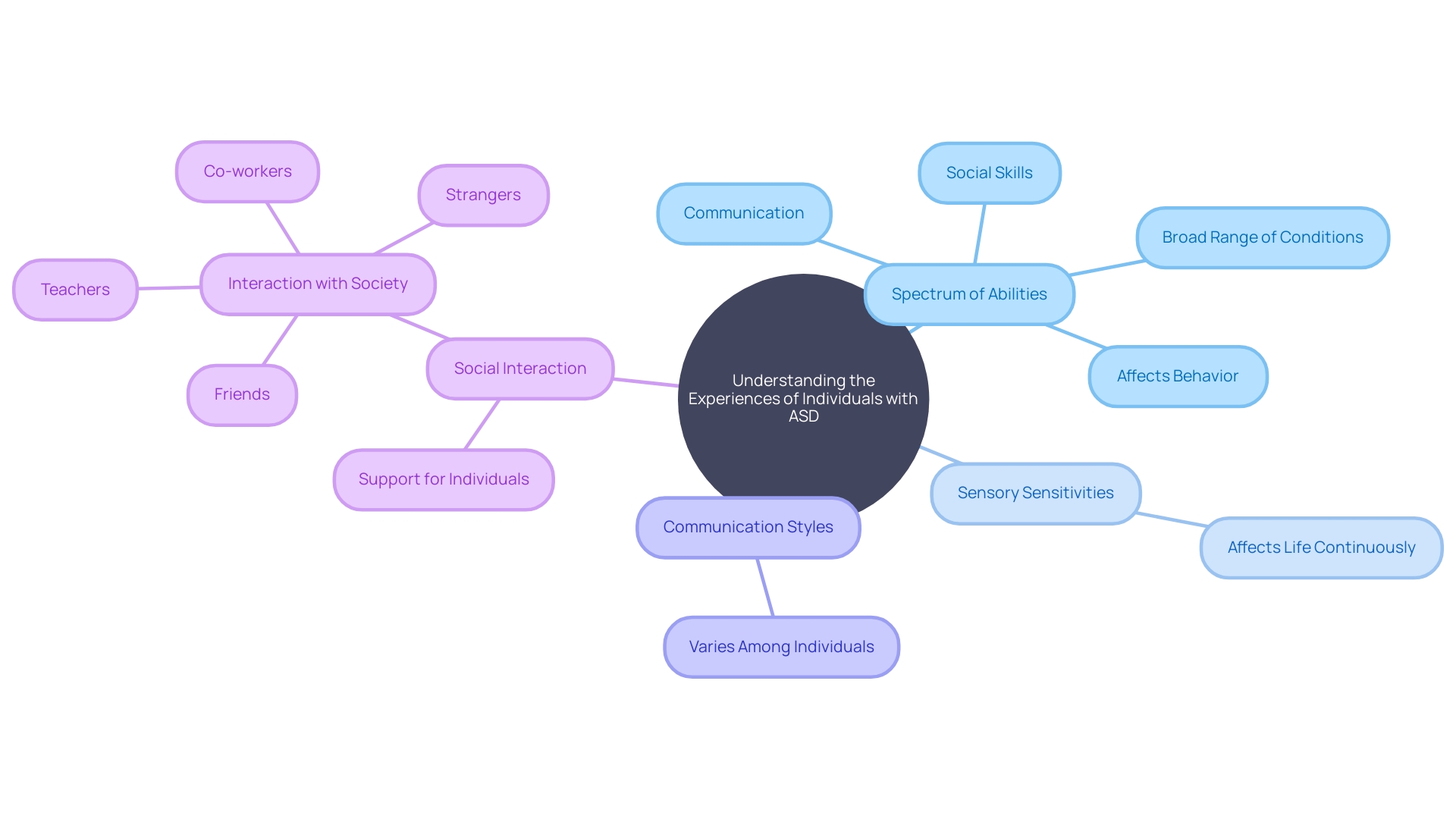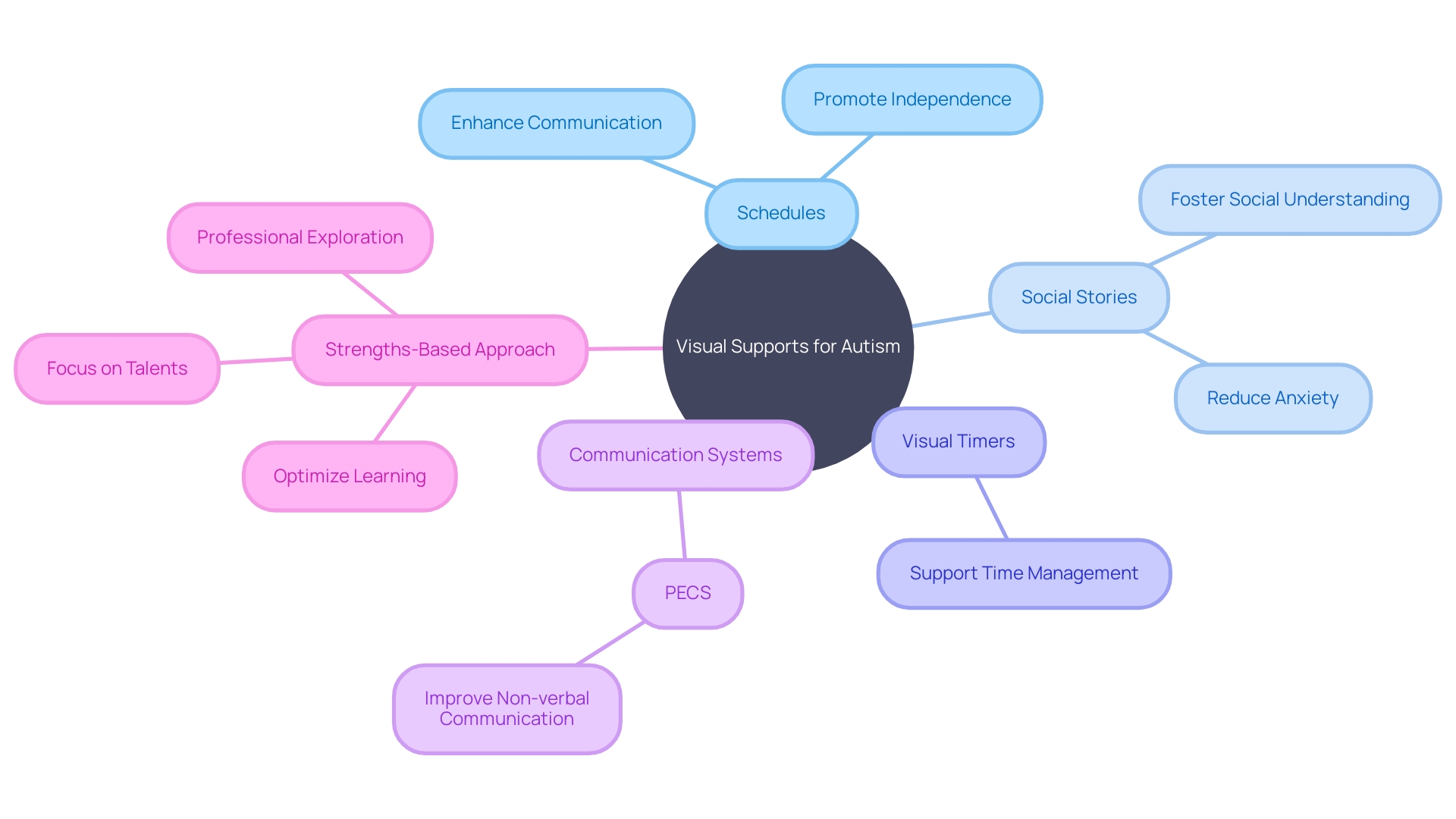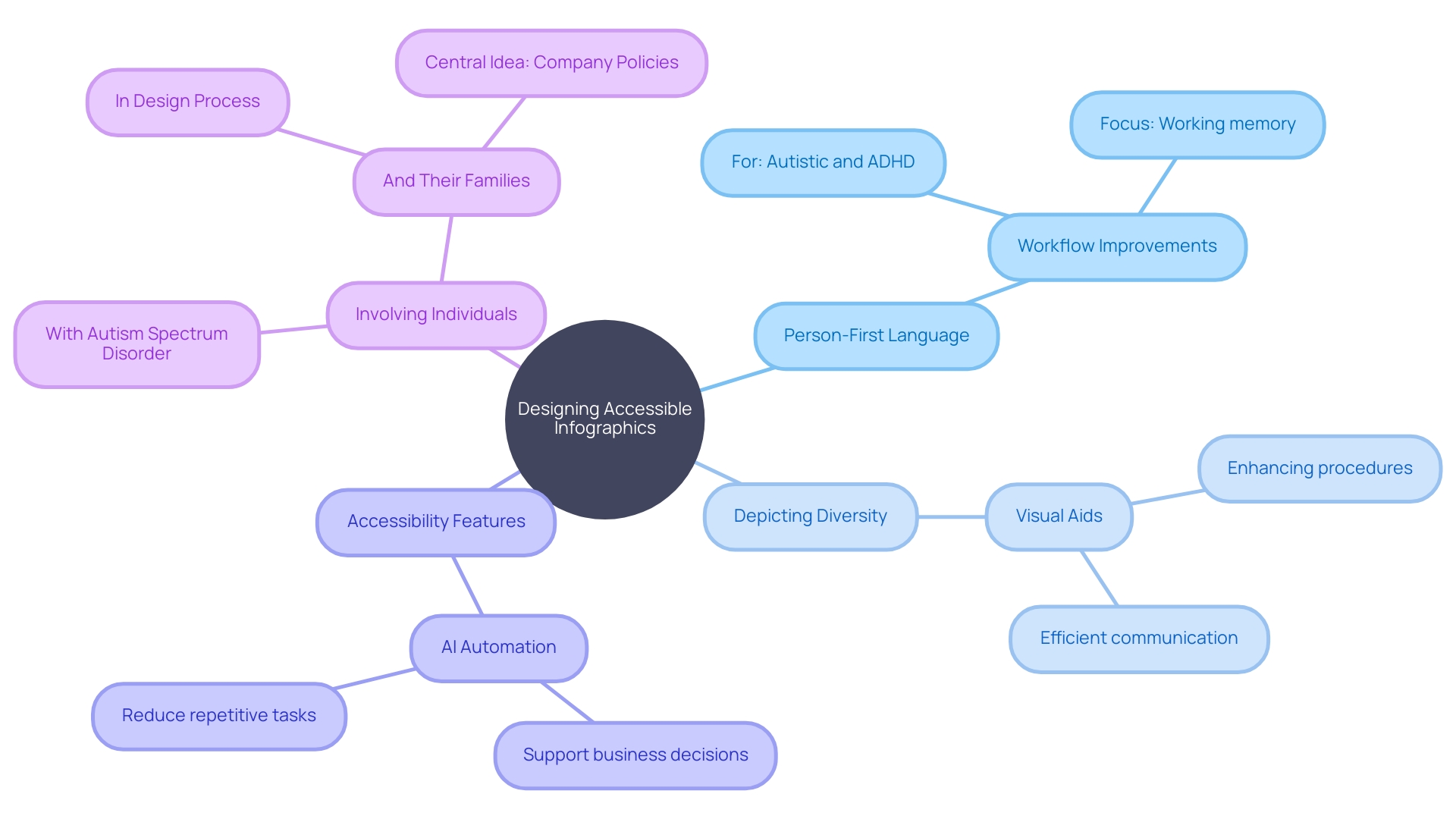Introduction
Autism Spectrum Disorder (ASD) affects individuals' social skills, communication, and behavior, making it crucial to understand and support the unique experiences of those on the spectrum. With a prevalence as high as 1 in 36 individuals, creating inclusive communities that address the needs of individuals with ASD is essential. This article explores various aspects of autism, including understanding the spectrum, key elements for visualizing it, design principles for autism infographics, visual supports for autistic individuals, common misconceptions and challenges, and creating inclusive and accessible infographics.
By deepening our knowledge and adopting an empathetic approach, we can create supportive environments that celebrate the strengths and talents of those in the autism community.
Understanding the Autism Spectrum
Autism Spectrum Disorder (ASD) encompasses a wide variety of conditions that distinctively impact people's social skills, communication, and behavior. Recognized as a lifelong condition, ASD's manifestations can vary significantly, making it imperative to appreciate each person's distinct experience with the spectrum. With a prevalence as high as 1 in 36 people, understanding ASD is crucial for fostering inclusive communities where everyone's needs are acknowledged and supported.
ASD is characterized by consistent differences in communication, social interactions, and relationships across various environments. These differences may appear as restricted and repetitive behaviors, such as echolalia, which is the repetition of sounds or phrases, or an overwhelming preference for sameness that challenges transitions or changes in routine.
The search for ASD's origins reveals that it is linked to variations in brain structure and function. While no single cause has been pinpointed, research suggests genetic contributions to ASD, with brain scans revealing distinctive differences in brain shape and structure when compared to neurotypical development. Misconceptions about the causes of ASD have been dispelled, clarifying that vaccines, parenting styles, and nutrition are not to blame.
Experts highlight the importance of early diagnosis, which can result in interventions offering the necessary resources to support people with ASD. Engaging with primary physicians and specialists is a common pathway for families seeking answers and assistance.
The neurodiversity movement celebrates the variation of human minds, including the condition often associated with autism, as an essential and valued aspect of society. It challenges the pursuit of a 'normal' brain and advocates for acceptance and appreciation of neurological differences. This paradigm shift has been gaining momentum, with discussions on neurodiversity expanding into various sectors and communities.
Groundbreaking studies are furthering our understanding of ASD. For instance, research at The Center for Discovery has utilized AI and machine learning to predict behaviors in individuals with ASD, aiming to mitigate their impact. Moreover, a genetics-first approach reveals how genetic mutations associated with ASD may affect neural circuits, with implications for treatment and understanding of the condition.
These insights highlight the intricacy of ASD and the importance of customized approaches that respect the uniqueness of each person with ASD. As our understanding expands, so does our ability to create supportive environments that champion the strengths and talents of those within the community affected by autism.
Key Elements for Visualizing the Spectrum
Producing an infographic about ASD necessitates a nuanced approach to encapsulate the diverse experiences of individuals with autism spectrum disorder (ASD). An effective visual tool would not only raise awareness but also foster a deeper understanding. To this end, consider the following critical components:
-
Spectrum of Abilities: Demonstrate the diverse range of capabilities and strengths of individuals, highlighting talents and interests that represent their distinct perspectives and contributions.
-
Sensory Sensitivities: Provide clear examples of sensory sensitivities that those with ASD may encounter, such as aversions to certain sounds or textures, and demonstrate their potential effects on everyday activities.
-
Communication Styles: Highlight the variety of communication methods used by individuals with a specific developmental disorder, ranging from verbal communication to alternative methods like sign language or picture exchange systems.
-
Social Interaction: Provide explanations of the different ways individuals with neurodevelopmental differences engage socially, identifying both the challenges they may encounter and the strategies that can result in favorable interactions.
Infographics serve as a powerful conduit for complex information, simplifying intricate concepts into digestible visuals. By incorporating these elements, your infographic will not only inform but also support the inclusion of people with ASD in all facets of society.

Design Principles for Autism Infographics
Creating an autism infographic is not just about aesthetics; it's a strategic effort to make complex information more digestible and accessible. To accomplish this, the infographic should be anchored in simplicity, using clean and straightforward visuals to avoid overwhelming the audience. A well-considered color palette is crucial, incorporating soothing hues that facilitate calmness without causing strain through harsh contrasts.
The organization of information is equally important, employing a hierarchy that effectively steers the viewer's focus toward the most crucial data. Size, color, and strategic placement can all serve as guides in this respect. However, the inclusivity of the design is paramount. Accessibility features should be incorporated to cater to diverse abilities, such as providing alternative text for visual elements, opting for legible fonts and appropriate sizes, and considering additional resources like audio descriptions or translations.
These principles are not just theoretical but are grounded in real-world applications. For instance, when approaching the 2020 United States presidential results, the use of a traditional color-coded choropleth map necessitates an alt tag that provides context for those using screen readers, ensuring that all users have an equivalent understanding of the content. In the realm of technology and design, accessibility is not only a legal requirement, as outlined by the ADA and Section 508, but also an ethical imperative that enhances user experience for all, not just people with disabilities.
Inclusion and clarity in infographics can foster understanding and empathy, as seen in the use of role-playing games like Dungeons & Dragons to aid individuals with autism in forming social bonds. Through empathetic and intentional design, infographics become a potent tool for storytelling and communication, converting intricate or emotionally demanding subjects into engaging narratives that connect with a wide audience. This approach aligns with the belief that aids are essential for streamlining communication, spotting patterns, and facilitating informed decision-making, ultimately contributing to improved outcomes and transparency in various domains.
Visual Supports for Autistic Individuals
Autism Spectrum Disorder (ASD) presents a diverse range of challenges and strengths, which requires a multifaceted approach to support communication and learning. Visual supports have emerged as a crucial tool in enhancing the daily lives of autistic people.
For example, schedules that are based on images can serve as a roadmap for daily routines, providing predictability and structure, which are often comforting to those on the autism spectrum. They can represent sequences of activities or highlight transitions from one task to another, thereby reducing anxiety about the unknown.
Social stories, another compelling tool, offer step-by-step explanations of social interactions, helping autistic individuals understand and navigate complex social norms. These narrative guides can foster better social understanding and highlight appropriate responses to social cues.
Visual timers are yet another aid, providing clear and concrete cues about the passage of time, which can be an abstract concept for many with ASD. These timers help with time management and can reduce the stress of transitioning from one activity to another by providing a countdown.
Moreover, communication tools like Picture Exchange Communication Systems (PECS) empower individuals who may struggle with verbal communication by enabling them to express their needs and desires through pictures, promoting increased independence and minimizing frustration.
By incorporating these visual supports into an infographic about autism, one can illuminate the practical applications of these tools, potentially transforming the educational and communicative experiences for individuals with autism, celebrating their unique perspectives, and promoting a strengths-based approach to learning and interaction.

Common Misconceptions and Challenges
Autism Spectrum Disorder (ASD) is a neurodevelopmental condition with a wide range of symptoms, abilities, and levels of disability. ASD's core characteristics include challenges with social communication, alongside repetitive behaviors and interests. These complexities make it vital to address misunderstandings directly, ensuring that knowledge about this condition is based on reality, not imagination.
One pervasive stereotype is that all autistic people possess extraordinary talents or savant abilities. While some do have exceptional skills, this is not the case for everyone with this condition. Dispelling this myth is crucial in understanding the diversity and individuality of the autistic community.
The negative perception surrounding a certain developmental disorder can be harmful, affecting not just people but also their families. It can lead to social isolation and barriers to accessing necessary services. By challenging this stigma, we can foster a more accepting society that recognizes the value of every individual, regardless of neurodiversity.
Misunderstandings about the condition continue, mainly because of a shortage of thorough research and education. For example, studies on the condition in non-Western countries is limited, and historically, ASD was mistakenly believed to be limited to Western populations. However, the condition is observed among all ethnic, racial, and socioeconomic groups. Raising consciousness and comprehension is crucial for establishing inclusive surroundings for people on the autism spectrum globally.
Access to suitable services remains a challenge for many on the spectrum. Innovative initiatives, like Emirates and Dubai International Airport's collaboration to simulate travel experiences for neurodivergent passengers, demonstrate the importance of tailored support. Such efforts can significantly enhance the quality of life for autistic individuals and their families.
In dealing with these aspects, we not only rectify popular misunderstandings but also emphasize the significance of personalized treatment and the worldwide scope of the condition. With empathy and informed communication, we can make strides towards a society that fully embraces neurodiversity.
Creating an Inclusive and Accessible Infographic
Designing an infographic that connects with and is accessible to everyone involves a few key strategies. Firstly, using person-first language ensures that people with autism are acknowledged for their personhood above all. This means refraining from using outdated or potentially offensive terminology. Secondly, the visual representation should depict the diverse range of the community affected by this condition, showcasing people of different ages, genders, and cultural backgrounds.
Accessibility is paramount; thus, incorporating features like alternative text for images, video captions, and text-to-speech options is essential. These components empower people with different capabilities to fully interact with the content. Moreover, a collaborative approach to design is beneficial. Involving individuals with autism spectrum disorder and their families in the development process can provide invaluable insights, ensuring the final product authentically represents their experiences and perspectives.
By focusing on these aspects, infographics become more than just a visual aid—they transform into a storytelling tool that can aid in understanding complex information, reveal patterns, and highlight potential issues. As a result, they become a powerful instrument for advocacy, education, and fostering inclusivity within the autism community.

Conclusion
In conclusion, it is crucial to understand and support individuals with Autism Spectrum Disorder (ASD) by creating inclusive communities that address their unique needs. Visualizing the spectrum through infographics can raise awareness and foster a deeper understanding of autism, highlighting abilities, sensory sensitivities, communication styles, and social interactions.
Design principles for autism infographics prioritize simplicity, inclusivity, and accessibility, ensuring that the information is easily understood and engaging for all. Visual supports such as schedules, social stories, timers, and communication tools play a vital role in supporting autistic individuals, promoting a strengths-based approach to learning and interaction.
Addressing misconceptions and challenges surrounding autism is essential. By dispelling stereotypes, challenging stigma, increasing awareness, and improving access to services, we can create inclusive environments that celebrate neurodiversity.
Creating inclusive and accessible infographics involves adopting person-first language, showcasing diversity, and incorporating accessibility features. Collaboration with individuals with autism and their families ensures authenticity and representation in the design process.
In conclusion, by deepening our understanding, adopting an empathetic approach, and creating inclusive and accessible infographics, we can support individuals with autism, celebrate their strengths, and create supportive environments that champion their well-being and success. Together, we can foster inclusivity and acceptance within the autism community.




